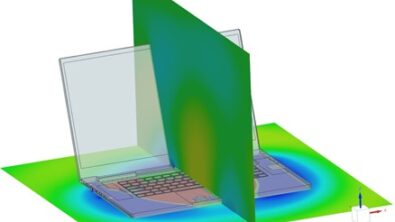Electromagnetics in the Age of Industry 4.0

Imagine our lives without our smart gadgets? La vie without electromagnetics? In fact, go a step further, the very existence of life on earth depends on the Earth’s magnetic field. Without it, solar winds, which is a flow of charged particles from the sun to the earth, would strip the earth’s atmosphere and oceans. This happened on Mars, as revealed by the MAVEN mission.
Let’s back up a bit. Are you reading this from a smartphone, tablet, laptop, or computer? To scroll we touch the screen, pad, or use the mouse. Our inputs are converted into electronic signals – a form of electromagnetic (EM) waves, which are channeled to the processor; again as EM waves for interpretation. The screen gets updated, as confirmed by our EM-based optical sensory system; the eyes, and the nervous system.
 The modern life is made possible by harnessing the power of the EM spectrum
The modern life is made possible by harnessing the power of the EM spectrum
We can’t forget the convenience of electricity in providing comfort in our homes and workplaces – lighting, and climate control. Enjoying music, watching the news, going out for a movie, calling family and friends, and logging our fitness via trackers. The connectivity within and beyond our doors is made possible by harnessing the power of the EM spectrum. This is truly the fabric that connects us!
On the lower frequency end of the spectrum, we transmit and convert electrical energy, listen to radio, watch TV, and monitor our babies. As the frequency increases, we communicate, we warm our food in microwaves, we use remotes and sensors to control things, and we also protect our eyes and skin from UV. At the other end of the spectrum, we use the higher frequencies in medical diagnosis and treatments, material characterization and testing, measurements as well as in manufacturing production methods. How can we forget airport security? BUT, we have to always shield ourselves from the ionizing radiations.

Brief Background
Electromagnetic engineering is not new but revolutionary. It is playing a very prominent role in the interconnected world that we live in, and its role will only increase as IoT and Industry 4.0 revolutionize the way we interact with each other, our products, and how we manufacture them.
Historically, the understanding of electromagnetic fields dates back to the pioneering work of the British scientist Michael Faraday, and the French physicist André-Marie Ampère in the early 1800s. The Scottish scientist James Maxwell among others improved the basic concept, suggesting a field rather than a fluid in the 1860s. All these led to a rather complete understanding of electromagnetic field behavior over 150 years ago.
Today we do not give a second thought to all these. However, EM waves convert and transmit energy as well as information. They cover space and can propagate in a vacuum. We know they exist by the forces exhibited on materials placed in an EM field, such as, iron fillings interacting with a magnet. By changing the field structure, information can be transmitted wirelessly between a source and a receiver. By placing materials in the field, the field distribution can be used to generate mechanical forces and torques, and the field itself can act as an energy storage system.
High or Low Frequency?
As illustrated before, electromagnetics is not a one-size-fits-all job. Hence, experts typically categorize electromagnetic field as radiated/propagating or not, i.e., “high” or “low” frequency electromagnetics. Each has its own typical characteristics, methodology, and application.
In general, this classification depends on the “electric size of the system”, which is the ratio of the size of the physical system to the EM wavelength.
For example, an electric motor with a dimension of one meter running at 50 Hz, has a wavelength of about 6000 km, giving a size-to-wavelength ratio of about 0.00017. Consequently, this EM wave is not expected to propagate inside the electric motor. So, this is considered a low-frequency project.
Radars used in automotive advanced driver assist systems (ADAS) are an example of a high frequency application. Typically, they operate at 77 GHz, corresponding to roughly a 4 mm wavelength. In this case, the ratio between the size of the system (the vehicle) and the wavelength is about 500 and the wave will propagate. Hence, it is a high frequency project.
 IoT and Industry 4.0 applications
IoT and Industry 4.0 applications
As simulation technologies and computing power become more advanced, IoT and Industry 4.0 engineers and analysts will have to implement diverse EM scenarios. The applications range from energy conversion to airplanes struck by lightning, to communication, emissions and compatibility issues of connected cars and appliances in our home and offices, to the automated factories where they are produced. All these applications require different types of cut-for-purpose simulation and design tools.
I invite you to read this white paper, from which part of this blog was drawn. The whitepaper discusses design solutions meant to meet the challenges of Industry 4.0 in the automotive and aerospace industries.



Comments
Comments are closed.